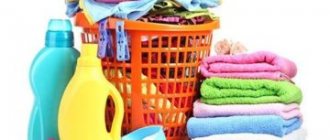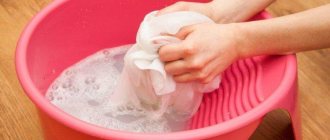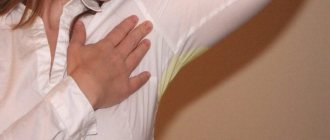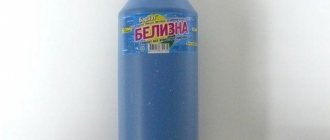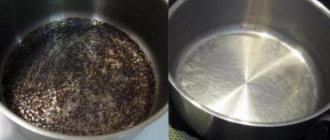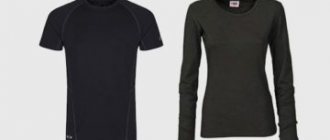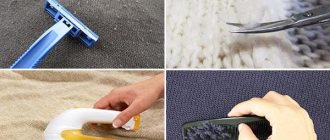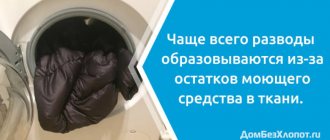Every housewife has had to deal with the problem of yellow spots appearing on white things. They cannot be washed either by hand or in a washing machine, and after using chlorine bleaches they can become darker and more noticeable. How to remove yellow stains from sweat without damaging the fabric? What means can be used? How to put things in order that have old stains?
Before moving on to the question of how to remove yellow spots from white, you should understand the nature of their origin and know how you can prevent their appearance on things.
Why do yellow marks appear on clothes and underwear?
It is impossible to give an exact answer to the question of why yellow spots appear on white fabric. However, a number of factors can be identified that contribute to the formation of yellowness:
- Sweating. Sweat contains large quantities of urea, which forms a yellow “sediment” that is especially noticeable on white things.
- Use of deodorants. Cosmetics can combat the odor of sweat, but do not prevent its formation. Particles of sweat, combining with substances included in deodorants, contribute to the appearance of stains.
- Long-term storage. Traces of yellow color appear on white things that have been lying in the closet or on the mezzanine for a long time. Such defects are not easy to remove; you will have to put in a lot of effort.
- Increased air humidity. If the air in the room where the clothes are located is too humid, this can cause the appearance of the white fabric to change.
- Composition of washing powder and its concentration. Sometimes it is enough to change the detergent, or not use it as much, and the problem of yellow spots will disappear by itself.
- Whitening products. Bleach often causes yellow stains to appear on white clothes. This occurs when this product is used incorrectly or due to the chlorine content in it.
- Wash in hot water. It is not recommended to wash most materials in hot water; this leads to the fact that not only the existing dirt “eats” into the fibers more strongly, but also unnecessary yellowness appears.
- Highly hard water. Metal salts give water hardness, and the more of them it contains, the harder the water. If these substances come into contact with fabric in large quantities, yellow spots may also appear.
- Using steam irons. You can often find yellow or rust marks on a white T-shirt or bed linen immediately after they have been ironed. This happens in cases where the owner neglects to clean the iron and rust accumulates inside it.
These factors contribute to the appearance of persistent stains on white items. However, if you find stains on your favorite T-shirt, blouse, bed linen or white panties, do not despair. There are many ways to remove yellow spots.
Mold in the powder compartment or pipes
Such phenomena can be found in homes where washing machine maintenance was completely absent or was carried out incorrectly. As a rule, this also happens when a person, after finishing washing, closes the powder compartment and the drum, not allowing them to dry properly.
Mold is a “lover” of dampness and, if you add a warm environment to this factor, you can create almost ideal conditions for it to form a huge amount of black mold, which will begin to release a large number of harmful spores into the air.
Where does mold most often form in the “insides” of a washing machine:
- In the cuvette (compartment) for pouring washing powder;
- In the pipes that lead from the cuvette to the water tank;
- On the walls of the drum;
- On the cuff;
- Inside the water tank.
Anyone with a normal sense of smell will be able to determine the “presence” of mold - its smell will immediately give everything away. Just stick your head into the drum and the pungent “aroma” will immediately hit your nostrils.
This will be the main reason to take a closer look at the remaining components of the stirlak. The procedure is like this:
- Carefully bend the hatch cuff and inspect the cracks;
- Take a look at the walls of the drum;
- Look also in the compartment for filling the detergent;
- Remove the compartment and inspect its opening.
In most cases, you will quickly discover an extremely unpleasant-looking black “cap” that has begun to develop in your machine. And, when clothes come into contact with this mold, they “acquire” dark, smeared dirt.
If this is your situation, it needs to be resolved extremely quickly. To do this, pour 300 g of baking soda into the compartment, turn on the highest temperature setting, and run the machine “idle” with double rinsing.
Such an aggressive “washing” of the machine itself will allow you to forget about the unpleasant problem with mold for a long time. If after the first time it doesn’t work, that’s okay, the process can be repeated until the mold disappears completely.
How to remove yellow stains from white clothes at home
In order to remove yellow stains on clothes, which can form not only due to sweat, but also for a number of other reasons, there is no need to spend money on expensive stain removers. You can use inexpensive and accessible means.
Vinegar and laundry soap
This method is suitable for white items made from thick fabrics. Vinegar will ruin wool or silk fabric.
- Moisten the problem area with vinegar and leave for 5-7 minutes. Afterwards, rub the stain generously with laundry soap.
- After 10–12 hours, rinse off any remaining soap with plenty of water and wash your clothes as usual.
Toothpaste
Dye-free toothpaste will help remove yellow stains and tidy up your white T-shirt or underwear.
- Gently apply the product to the stain and leave the item until the paste dries completely. Afterwards, rinse off the product with warm water.
- It should be noted that this method is effective for combating fresh stains; it is difficult to remove old stains in this way.
Oxalic acid and laundry soap
A yellowed item can be put in order using a solution of oxalic acid (1 teaspoon of the product is diluted in 1 glass of water).
- Before you begin removing stains, wash the item thoroughly with laundry soap, paying special attention to problem areas. After this, moisten the stains generously with an acidic solution, leave for a few minutes, and then wash the item again.
The same method can be used by replacing oxalic acid with citric acid.
Liquid soap, soda and peroxide
How to remove yellow stains with these products? Mix soap, baking soda and peroxide in a ratio of 1:2:4. Apply the resulting gel to the stains using an old toothbrush. After 2-3 hours, remove the remaining “stain remover” from the T-shirt or shirt and wash the item.
In this case, it is better not to use a washing machine, but to wash the product by hand.
Aspirin
It is not difficult to remove yellow stains on white clothes with aspirin, but it will take a lot of time.
- Grind several acetylsalicylic acid tablets to a powder and dilute with warm water to form a “paste.” Apply the resulting product to the stains, and after a few hours wash the item.
It must be remembered that aspirin has a bleaching effect, so you should not use it to remove yellow stains from colored or black clothes.
White spirit and ammonia solution (ammonia)
How to remove yellow stains from sweat, or those that have arisen for other reasons, in this way?
- The products are mixed in equal quantities, and the resulting solution is used to treat contaminants. After 3-5 minutes, the item must be rinsed and then put into the washing machine.
This method will help remove yellow stains not only on white, but also on colored or black clothes, even if the stains are quite old.
Water and powder
Poor quality detergent
One of the most common reasons is bad powder. Even if the machine has been washing with the same powder for a long time and has never spoiled things before, this does not give any guarantee that this will happen all the time.
Powders are also counterfeited, for example, or batches are defective.
Anything can happen. By what signs can you determine the quality of the powder?
Bad powder:
- Almost insoluble in water. There is a lot of undissolved product in the powder compartment, as well as granules on clothes.
- Does not produce foam or provides it in excess. With a good detergent, the amount of foam is moderate.
- Leaves an unpleasant chemical odor that takes a very long time to dissipate.
If you think that the powder is to blame for the appearance of stains on clothes after washing, you can wash the clothes with a different detergent next time and see the result.
How to check whether the powder is to blame for the stains?
Stains caused by low-quality powder can be of different colors: green, red, light brown or yellow, rainbow, white.
If there are white spots on the laundry after washing, then restarting the washing program without using washing powder should save the clothes.
Causes of white spots
Reason 1. Low water pressure
If the powder is poured into the detergent tray and cannot get into the drum at the beginning of the wash, then the reason lies in low water pressure. Thus, the detergent gets on things when the “rinse” mode has already started and, of course, the machine does not have time to get rid of it. The detergent remains on the clothes, which causes stains on the laundry.
If it is not possible to increase the water pressure, then you can solve the problem of white spots after washing using a dispenser that is placed in the drum with clothes. Or another way to solve the problem is to use liquid detergents. They have a difference from powder - the absence of bleaching components. This is important when using such products regularly, as there is a high possibility of mucus and black mold appearing in the car. To prevent this from happening, it is enough to regularly carry out preventive cleaning of the washing machine.
Reason 2. Too much laundry
A large amount of laundry in the car, that is, overload. In this case, the detergent simply gets stuck in the clothes and cannot dissolve. Even when using a dispenser in a drum, this problem can occur.
Reason 3. Not enough powder
Strong products for stubborn stains
If the listed methods do not help remove yellow marks on clothing, you can use the following highly effective products. They will help restore the whiteness of a T-shirt or blouse, even if the item has been lying around for a long time and the stains on it are old.
Prepare a solution from the following ingredients:
- purified gasoline - 30 ml;
- denatured alcohol (technical alcohol) – 40 ml;
- ammonia – 20 ml.
The solution is applied to the fabric for no more than 5 minutes, after which the item is washed as usual.
Citric acid and rubbing alcohol
Add a little lemon to a small amount of alcohol (0.5–1 tablespoons). Soak the stain in the solution for 3-5 minutes, then put the item in the washing machine.
Vegetable oil and bleach
Soak yellowed items in a solution of the following ingredients:
- chlorine-free bleach – 2 tablespoons;
- vegetable oil (any) – 2 tablespoons;
- washing powder – ¾ cup;
- boiling water – 5 l.
Place the soiled items in a container with the solution and wait until the water cools. Afterwards, wash your clothes in the machine. In some cases, vinegar (2 tablespoons) is added to the solution, this helps enhance the effect.
Gasoline or turpentine
Since these substances are aggressive, they are applied to the stains for a few minutes to avoid damaging the fabric. Afterwards the item is washed as usual.
It should be noted that the above methods are suitable for fabrics with a dense structure; a blouse made of thin material will be hopelessly damaged by strong products.
Possible causes of stains after washing
Why does a washing machine dirty and not wash?
This is, of course, strange. For many years, your assistant coped with her task without complaints and suddenly she began to mischief, dirtying everything that fell into her drum. There is a reason for this, and not just one.
- Dirty water.
- Bad washing powder.
- Dirt in the cuff.
- The bearing or oil seal has failed.
- Mold.
If you encounter stains on your laundry after washing, your machine probably has one of the above reasons. It is because of them that brown, gray, white, black, green spots appear on washed laundry. And believe me, it’s rare that the machine is to blame for this; it’s mostly due to mistakes or lack of proper care by the owner of the equipment.
According to statistics, the cause of stains on clothes due to manufacturing defects lies in only 0.5% of cases. Any equipment requires care, and if we talk about a washing machine, then even more so!
How to remove yellow stains from delicate fabrics
Items made from delicate fabrics, such as wool or silk, often cannot be washed normally, and not every product is suitable for removing yellow stains from such clothes. Aggressive substances lead to thinning of fabric fibers and sometimes to the appearance of holes.
How to remove yellow stains from delicate fabrics? There are several ways:
- If the item is silk, you can prepare a mixture of 10–15 drops of glycerin and 3 drops of ammonia. The resulting solution is applied to the stain for 15–20 minutes, after which the item is washed as usual.
- These products are also suitable for woolen items, only glycerin and ammonia are diluted with a small amount of warm water.
- Hyposulfite (thiosulfate) will also help in the fight against stains. This chemical was once used in darkrooms, but today can be found in pharmacies or home improvement stores.
Dissolve hyposulfite crystals in a glass of water and wipe the stains with the solution, then rinse the item in warm water.
Using these tips on how to remove yellow stains from sweat or other factors, you can achieve the ideal condition of your things. If none of the above methods help, use dry cleaning services; home “experiments” can lead to disastrous results.
Failure of bearings and oil seal
Oily stains on clothing indicate that the oil seal has become unusable. Such contaminants on clothing appear when the lubricant applied to the oil seal penetrates into the tank
. To eliminate the malfunction, it is necessary to repair or replace the oil seal.
A damaged oil seal is often the cause of bearing failure. In such situations, the machine begins to make a lot of noise during the spin cycle, dirtying the laundry and leaking
. Frequent washing at 90 degrees can cause damage to the oil seal and bearings. Exposure to high temperatures can cause the oil seal to dry out and become deformed, which leads to water penetrating into it and washing away the lubricant.
Replacing bearings and oil seals on your own is problematic; it is advisable to take the help of professionals.
Household chemicals for removing yellow spots
Specialized household chemicals successfully remove yellow stains from white clothes. Stain removers are used for white and colored items, bleaches are used only for whites. Liquid and gel products are suitable for thin and delicate fabrics; more aggressive powders will remove yellow stains from cotton and denim. The method of application and exposure time differ for different products; read the packaging. Here are some effective bleaches:
- Liquid stain remover Vanish OXI Action. Removes any stains, refreshes white clothes, enhances the effect of the detergent. The approximate cost is from 130 rubles for 450 ml.
- Bleach SARMA Active. An effective remedy for any contamination. Suitable for all types of fabric. Does not contain chlorine. The approximate price is from 105 rubles per 500 grams.
- Bleach Bos plus Maximum. Removes stubborn stains and preserves the color of the product. Works even in cold water. Approximate price - from 59 rubles for 250 g.
Good advice
With some effort, you can easily remove yellow stains from your clothes and continue wearing your favorite item.
And a few additional tips will help eliminate this annoying defect and keep the fabric fibers in their original form:
- The most suitable water temperature for removing old stains should be between 20° and 30°. Hotter water will only set the yellow color on the fabric. The only exception is clothing that is 100% cotton. Such things can even be boiled.
- Before removing yellow stains, you need to check the effect of the product used on the fabric. It is best to carry out this test on saved small scraps, which are usually attached to new clothing along with a tag. If such a flap is lost, then the check should be carried out in the most inconspicuous place. Most often, this can be done using the hem of the product, an internal seam, etc.
- Trying to remove old stains, many try to use chlorine-containing products. However, in this case, the fiber structure of the fabric very often deteriorates, and the item completely loses its appearance.
- You should never use products such as acetone or vinegar to remove stains from silk fabric. These aggressive substances will not just damage the fabric, but will burn a hole in it.
- Nylon and nylon threads dissolve under the influence of substances such as gasoline, acetone, etc.
Don't throw away your favorite white clothes if yellow stains appear on them! With a little effort and time, you can return your clothes to their original appearance.
Is it possible to paint over stains on fabric and how to do it?
If the listed remedies do not help, the yellow spots are painted over. The color of light, monochromatic items can be simply refreshed or radically changed with factory dyes. Dye only things made from natural materials; synthetics are difficult to dye, and the result can be unpredictable. Fabric paints come in different forms: powder, paste or granules. Choose them not only by color, but also by type of material. For coloring:
- Wash and dry the item you will be dyeing in advance.
- Buy fabric dye in the color you want.
- Dilute the paint as written in the instructions. Use distilled water or soften tap water (1 teaspoon of salt per 10 liters of water).
Acid dyes are used for wool, and vinegar is added to the water, in addition to salt. After dyeing, silk is also rinsed in water and vinegar to consolidate the result.
Old storage stains: basic washing principles
There are many ways to remove old stains from old clothes. Regardless of which one you choose, you must adhere to a number of rules:
- dirty things cannot be washed or even simply rinsed in hot water, since most stains from such a procedure only eat deeper into the fabric and become fixed there.
- the best water temperature for washing is room temperature;
- It is better to dry clothes made from natural fabrics of a light shade in the sun, since in this case ultraviolet radiation will contribute to the bleaching of textiles;
- proteins contained in sweat, reacting with chlorine, will make the stains darker, so yellow stains on clothes soaked in sweat cannot be washed with chlorine-containing compounds;
- if you had to use a chemical bleach or stain remover for children's clothing, then after that you should immediately wash it with soap to wash out possible allergens and irritants to the baby's skin from the fabric;
- New laundry detergents should be tested on a small area of fabric first to ensure that it does not damage the material. The same should be done with items being washed for the first time.
